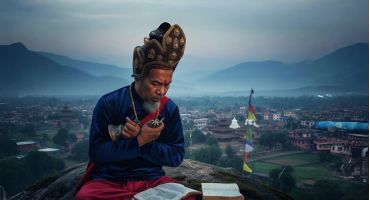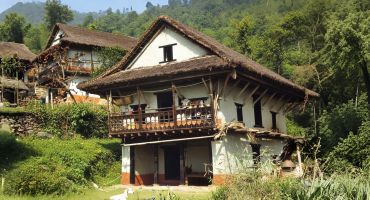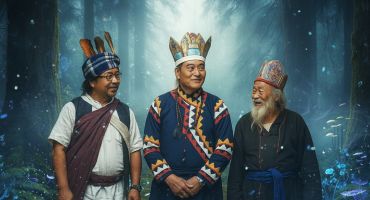The Kirati Khambu Rai envision the cosmos alive with a vast array of supernatural beings. In Kirati Khambu Rai culture, these entities are not neatly divided into categories such as “natural” and “supernatural,” or “earthly” and “spiritual.” Rather, the qualities implied by such distinctions are present, to varying degrees, in all beings. Every person, many animals, and even certain objects possess a soul-like, life- essence known as Lawa, which can be perceived through the shamanic authority and invisible in the physical world. In daily life, the Khambu indicate the presence of lawa by pointing to the chest or stomach, while for supernatural entities, they reserve the term Maang. Intriguingly, when a bodiless lawa enters the unseen realm, it can coalesce into the collective Maang. This transition shows a fluid understanding between human and divine in Khambu cosmology.
Maang occupies a central place in the Khambu animistic worldview, for these revered forces manifest as spirits or guardians, each intimately tied to a specific feature of the natural world. Maang can also refer to ancestral spirits who continue to guide and protect their descendants. Among the many spirits in the Kirati Khambu Rai belief system, the Sakela (or Sakewa) Maang holds a prominent position, alongside other tutelary and nature spirits. Beyond these, the pantheon includes eight additional divine beings, each highly esteemed and woven into the spiritual and social life of the community.

These revered divine spirits, collectively known as ‘Retkamang’, occupy a central place in Khambu Rai tradition. In the Bantawa language of the Khambu Rai people, Retka or Rekka signifies “eight,” while Maang, as discussed before, denotes a divine spirit. Significantly, the Khambu pantheon recognizes both feminine and masculine manifestations of these spirits: the feminine forms are called Sakuni Dimani, and the masculine forms Sakuchi Dipachi.
It should be understood that Sakela does not appear to be ‘primordial’ as it is mostly associated with the age of agriculture. In the Khambu spirit pantheon, there are older spirits than Sakela though it would not be right to delimit the historical horizon of Sakela. Some of the Retkamaang, which we shall indicate later, are clearly archaic, but that does not mean that they are “pure” and “primordial.” In the form in which we find it, the Khambu spirit pantheon is even decidedly marked by ancient Kirati occupational influences and geography.
Despite their antiquity, all eight divine spirits remain integral to the Sakela tradition, worshipped during the rite that precedes the Sakela/Sakewa festival. Within the Sakela ritual framework, these spirits are symbolically represented by stones arranged in a triangular pattern, typically placed to the right of a sacred Sakela shrine. The deliberate layout and sequence of the stones reflect the importance of ritual precision in honoring the ancestral lineage.
Although the Khambu venerate a multitude of divine spirits, the Retkamang hold particular significance in defining the essence of Sakela, and highlights the reciprocal relationship between human survival through cultivation and the reverent honoring of nature that sustains it.

These eight divine spirits are:
- Watupmaang
- Samkhamaang
- Helawamaang
- Budimaang
- Thampungmaang
- Baktangchumaang
- Tampchumaang
- Silimaang
Watupmaang
Watupmang represents the life-giving power of water. The name derives from the Khambu word for water, Wa, reflecting the reverence for rivers, springs, and other water sources that sustain the community. This spirit represents the vast networks of water and their convergence points, echoing the notion of the sea as a unifying force that nourishes all life. In the Kirat worldview, Watupmaang acknowledges water as a source of existence, an idea deeply rooted in the Mundum (oral narrative of the Kiratis) philosophy, which sees the cycles of the natural world as intimately connected to human consciousness and social life.
Before the Sakela rituals and the consecration of the shrine, all water sources around Khambu Rai settlements are carefully cleaned and purified. This practice emphasizes the link between ecology, and ritual, and it resonates with the etymology of Sakela or Sakewa itself, a term derived from Sakmawa, meaning “life-sustaining water.” Through these ceremonies, the Khambu Rai honor water both as a material necessity and also as a sacred, animating force that sustains their crops and their community.
Samkhamaang
Samkhamaang, known as the spirit of the hearthstones (samkhalung or suptulung), represents the collective ancestors of the Kirat household. This spirit underscores the centrality of the home and family unity, as the hearthstones are seen as sacred spaces where lineage and memory converge. In Kirati belief, the hearth serves as a doorway to the realm of ancestral spirits, thereby making it a focal point for communal gatherings and ritual practices.
Within Khambu culture, the first harvest of crops such as rice, millet, ginger, or cardamom is never consumed without first offering it to the ancestors. Similarly, the annual Chhowa, the ritual worship of ancestors, is observed on the auspicious day of Sakela. In this context, it is only fitting that Samkhamaang, the collective ancestral spirits, holds a place within the Sakela shrine, linking the domestic sphere to the larger spiritual and social life of the community.
Helawamaang
Helawamaang, associated with the monkey (helawa), honors the ancestral spirit of agrarian protection. While monkeys are often seen as crop destroyers, the Khambus have, since ancient times, coexisted with them under an unspoken covenant of boundaries and mutual respect. In Mundhum ritual speech, helawa is invoked to acknowledge this balance: the upper reaches of the farm are left for the monkeys, while the lower plots are reserved for humans. This practice reflects a sacred principle of living in harmony with all of nature’s sentient beings, however paradoxical it may seem. This principle is central to the Kirati Khambu worldview.
Helawamaang embodies an agrarian ethos in which the spirit is honored at harvest as an expression of gratitude for the protection and growth of crops. Furthermore, this can also be considered a ritual affirmation of interconnectedness with nature’s creatures, especially those that symbolize adaptive resilience.
Budhimaang
Among almost all Khambu sub-clans, there is a central matriarchal grandmother spirit, venerated annually alongside the ancestors during the Chhowa or Maangsewa ritual. In the Chamling dialect, she is called Machakomma, while in Bantawa, the term Masngchemma is used. Historical evidence suggests that this divine figure existed during the time of the Kirata dynasty in Kathmandu, as Lichhavi inscriptions refer to a mother deity under the term Matindevkul, indicating her worship in Kirata times.
Collectively referred to as Budhimang, a neutral Nepali term denoting this matriarchal figure within the Kirati pantheon, she represents not only this specific deity but also all female ancestors. Budhimang is a fiercely protective spirit, particularly toward female descendants. She is nurturing yet capable of great anger, embodying qualities associated with female strength and authority. Her presence highlights an ideological continuity within Kirat society, where reverence for maternal lineage and recognition of women’s roles in cultural preservation remain central.
Thampungmang
Thampungmaang, also known as Sikari, is perhaps the oldest divine spirit in the Khambu pantheon. The Khambu Rai believe that the forests are home to countless hunter spirits, and Thampungmaang reigns as their chief. Among the Kulung Rai, this spirit is called Diburim. In embodying the skills of survival and the knowledge of the environment that sustained their ancestors, Thampungmaang reveals the Khambu people’s deep-rooted connection to a hunter-gatherer way of life.
Reverence for the collective hunter spirits through Thampungmaang acknowledges the practical knowledge and ecological expertise of earlier generations. These ancestors demonstrated survival skills in navigating forests and tracking game in an inhospitable natural environment. Within Khambu cosmology, Shamans are understood as a part of these hunter spirits. It is believed that, upon death, a Shaman’s soul does not enter the ancestral realm. Rather, it is merged with these spirits, to become an integral component of the very force that guided them during life.
Baktangchumang
In the Khambu Bantawa language, Baktang means “shoulder.” This ancestral spirit signifies strength, endurance, and resilience. It conveys not only physical power but also a profound respect for human labor and effort. In Kirati folklore, Baktangchumang is associated with the ancestor Chappa, who cleared the forested hills to cultivate millet and establish the first agricultural settlements.
Baktangchumang marks a critical transformation in Khambu Rai history: the shift from a hunter-gatherer existence to a life grounded in agriculture. The spirit reflects the community’s recognition of the skill, knowledge, and persistence required to sustain cultivation. By venerating this ancestral force, the Khambu Rai honor both the practical and symbolic significance of human labor, framing agriculture as a sacred continuation of their ancestral heritage.
Tampachumaang
Tampachumaang is the ancient serpent spirit. The name comes from the Khambu word Pa, meaning “snake,” and signifies the spirit’s role as guardian of the fields. Since ancient times, Tampachumaang has protected cultivated land. Khambu tradition holds that anyone who trespasses into these fields without permission may fall into a state of catatonia or paralysis, which shows the authority of the spirit. After the harvest, the Khambu perform a ritual to honor the household granary, called bhakari, in which a separate Tampachumaang bhakari receives consecration and worship.
Serpents hold practical significance for farmers because they eliminate pests and rodents that threaten crops. Within Sakela cosmology, serpents also symbolize the health of springs and streams and act as indicators of water quality. Tampachumaang therefore functions both as a protector of crops and as a spiritual guarantor of the community’s well-being.
Silimaang
Sili Mang is the last of the eight divine spirits in the Khambu Rai pantheon. The word Sili refers to ritual dance, through which the Khambu Rai venerate divinity and express gratitude, often alongside the rites of the Shaman. In the Khambu worldview, Sili symbolizes the cycles of nature. During the dance, performers emulate the movements of Demoiselle Cranes flying in circles, enacting the rhythms of creation and reflecting the harmony of the natural world. The Khambu believe that Sili rituals have been performed since the earliest days of human civilization. To honor its antiquity and sacredness, the dance is never accompanied by melodic music and is performed exclusively to the beat of drums or cymbals.
Elders who mastered this art form have come to be revered as Sili Mang, ancestral spirits of dance and movement. Following this symbolic tradition, Sili Mang is formally recognized and honored during the worship of Sakewa, ensuring that the ritual, its cultural meaning, and spiritual significance continue across generations.

It is essential that these eight divine spirits be consecrated during the Sakela rituals. Whenever a Sakela shrine is established, shrines for the Retkamang must also be included. In the ritual arrangement, the Sakela stone, known as Sisamlung, occupies the northernmost position. With the principal Sakela idol at the northern tip, the remaining stones representing the divine spirits, except Thampungmaang, are arranged in a triangular or pyramidal formation on the ground.
The shrine dedicated to Thampungmaang is more elaborate than the others. It is adorned with wild banana leaves, bottle gourds (Wabuk), and weapons such as bows and arrows. This distinction reflects the belief that Thampungmaang belongs to a period earlier than the agricultural age, symbolizing a link to the community’s hunter ancestry.
During Sakela or Sakewa worship, the Nakhchhong (shaman) does not perform the rites solely under the authority of Sakela. The hierarchy and cooperation among the Nakhchhongs point to the moral and social order of civilization itself. The ritual begins only when the apprentice or assistant shamans have invoked and recited the Mundum through the Retkamang. Once this is done, the Sakela shaman performs the principal ceremony.
The consecration and worship of the Retkamang within the Sakela framework signify a veneration of the forces that have sustained Khambu Rai life across generations. Moreover, the Retkamang tradition in Kirat culture reveals a sophisticated synthesis of ancestral reverence and ecological consciousness where each spirit embodies an aspect of the Kirati heritage of survival. The worship of Retkamang is therefore an act of gratitude toward the divine powers that guard and protect the community.





Leave a Reply